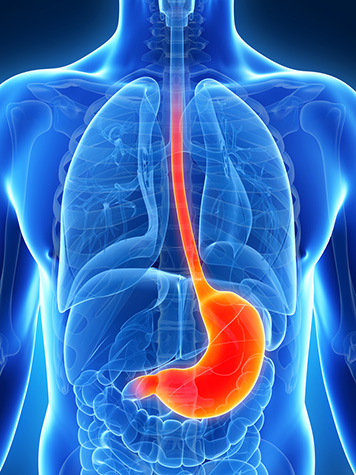Achalasia
Achalasia is a rare oesophageal motility disorder due to the failure of the lower oesophageal sphincter to relax and allow emptying. The main body of the oesophagus can also be affected and contractions can be absent or abnormal. The cause of achalasia is not known.
What are the symptoms?
Patients usually present with difficulty swallowing. They may also report regurgitation of food or fluid and chest pain.
How is it diagnosed?
 Any patient presenting with difficulty in swallowing is initially assessed by endoscopy. If no cause for the difficulty can be seen then the next test would be to investigate for abnormal motility of the oesophagus. Oesophageal manometry uses a thin tube inserted into the oesophagus to measure pressure during rest and normal swallowing. The tube measures the contractile strength and coordination of the oesophagus and its sphincters. This test is the most accurate to diagnose achalasia.
Any patient presenting with difficulty in swallowing is initially assessed by endoscopy. If no cause for the difficulty can be seen then the next test would be to investigate for abnormal motility of the oesophagus. Oesophageal manometry uses a thin tube inserted into the oesophagus to measure pressure during rest and normal swallowing. The tube measures the contractile strength and coordination of the oesophagus and its sphincters. This test is the most accurate to diagnose achalasia.
What are the treatments?
Achalasia can vary in its type – some types respond extremely well to surgery and others have more varied outcomes. All types have a high-pressure lower oesophageal sphincter, which does not relax with swallowing. Treatment aims to disrupt this lower oesophageal sphincter. This is usually done one of two ways;
– Endoscopic Dilation – a specially designed balloon is inflated in the lower oesophagus during endoscopy. The balloon disrupts the lower oesophageal sphincter. This is a good option for patients who are high risk for surgery. One problem, however, is that the effect is not as durable as surgery, and repeat procedures are usually necessary. For this reason balloon dilatation is usually not recommended for younger patients. Another concern is the risk of oesophageal perforation and post procedure gastro-oesophageal reflux.
– Laparoscopic Heller’s Cardiomyotomy – The surgical option for achalasia is an operation known as a Heller’s cardiomyotomy. This is performed using lapraroscopic or keyhole surgery, through a few tiny incisions in the abdominal wall. The operation involves division of the thickened muscular wall of the lower oesophageal sphincter to allow it to permanently open up. It is accompanied by a partial antireflux procedure to prevent reflux.
How long will it take to recover from the surgery?
Patients are fully mobile and should commence fluids immediately after surgery. Often, a check contrast study is performed after the procedure before patients start a soft diet. Patients remain on a soft diet for 4 weeks to allow the postoperative swelling to settle.
Patients will often require one or two nights in hospital. This is mainly to build confidence eating and drinking after the surgery. The wound sites will have local anaesthetic injected into them at the time of surgery. This will wear off about 6 hours after the procedure. To stop the sites becoming sore you should take the regular painkillers as instructed. Shoulder tip pain is not uncommon and is due to gas underneath the diaphragm. This should not last longer than 24 hours. You will not be discharged until you are comfortable and eating and drinking. On discharge you should be independent and able to climb a flight of stairs.
Which medications will I require after surgery?
You will be discharged from hospital with a supply of simple painkillers with instructions on how to use them. Regular paracetamol is particularly effective and can be combined with an anti-inflammatory drug (ibuprofen) or a codeine based drug (dihydrocodeine). Anti-inflammatories are not suitable for all patients and should be taken with food. The codeine-based drugs can cause constipation and should be taken with plenty of fluids. Most patients do not require painkillers after 5 days.
When can I return to work?
Generally it is recommended to take two weeks off after surgery. Your ability to return to work will depend on your job and varies between individuals. Patients can often return to work a week after surgery if required. We would not recommend flying immediately after surgery. This should be discussed on a case-by-case basis with the consultant.
When can I drive?
Driving should be avoided in the first week after surgery. Once you can perform an emergency stop in a stationary vehicle and turn to view your blind spot then driving should be safe. It is preferable to contact your insurance company to check for any specific instructions they may have.
What are the long-term outcomes from surgery?
Long-term results are good although it is rare for a patient’s swallowing to completely return to normal. Some patients will require long-term acid suppression medication and some will always find breads and meat difficult. There is a small increased risk of oesophageal cancer with achalasia and endoscopic surveillance should be performed during follow up. This does not need to be done for at least 5 years after symptom onset.
Who do I contact if there are concerns?
The group practice telephone is answered in working hours and messages can be left out of hours. Any concerns will be relayed directly to one of the consultant surgeons on receipt. The hospital ward also provides a 24/7 means of contact. They will contact the consultant about any concerns and are able to give advice if required.




